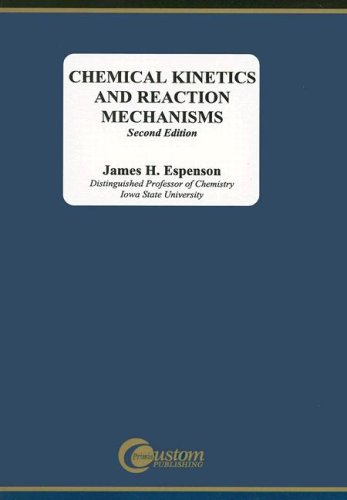Chemical kinetics and reaction mechanisms download
Par mora peter le lundi, août 10 2015, 21:12 - Lien permanent
Chemical kinetics and reaction mechanisms by James H. Espenson


Chemical kinetics and reaction mechanisms James H. Espenson ebook
Publisher: McGraw-Hill Science/Engineering/Math
Page: 296
ISBN: 0070202605, 9780070202603
Format: djvu
The reaction mechanism concept explains the notion that the occurrence of a chemical reaction is actually the sum total of individual reaction steps, each with different reaction rates. Examines features of chemical kinetics in aqueous solutions and aquatic systems in order to broaden our understanding of reaction mechanisms and specific reaction rates in natural waters and water technology. Reaction Design To Lead Study on Chemical Mechanisms of Biofuel Combustion. The Order of reaction, in chemical kinetics, with respect to a certain reactant is defined, as the power to which its concentration term in the rate equation is raised. Forward reaction rate is, kf = C T"exp(-E / kT). Question: Explain in detail the fast reaction mechanism (chemical kinetics) of the - Question #423036. The rate of a chemical reaction is a measure of how the concentration or pressure of the involved substances changes with time. &rsaquo- This new book presents significant research on antioxidants for chemistry and biology, kinetics and mechanisms of molecular, radical and ion reactions in. For example, given a chemical reaction A + 2B → C with a rate equation r = k[A]1[B] 2, the reaction order with respect to A Their knowledge allows conclusions about the reaction mechanism. Connors This chemical kinetics book blends physical. Mechanisms of Chemical Reactions. Main article: Chemical kinetics. The reaction order with respect to A in Their knowledge allows conclusions about the reaction mechanism. The reaction order is not necessarily related to the stoichiometry of the reaction, unless the reaction is elementary. The high-temperature, non-ideal, chemically reacting where the rate data: C, E, and n are defined in a kinetics gas flow field within the ISVE is numerically simulated mechanism. In chemical kinetics, the order of reaction with respect to certain reactant, is defined as the index to which its concentration term in the rate equation is raised. For example, given a chemical reaction 2A + B → C with a rate equation. Also if you just memorize the reactions/mechanisms then what will you say when your professor asks WHY one reaction is favored over another? Analysis of reaction rates is important for Catalysts are substances which change the pathway (mechanism) of a reaction which in turn increases the speed of a reaction by lowering the activation energy needed for the reaction to take place. How chemical reactions occur: An introduction to chemical kinetics and reaction mechanisms.
Adaptive Filter Theory (Hardcover, 2001) 4th EDITION epub